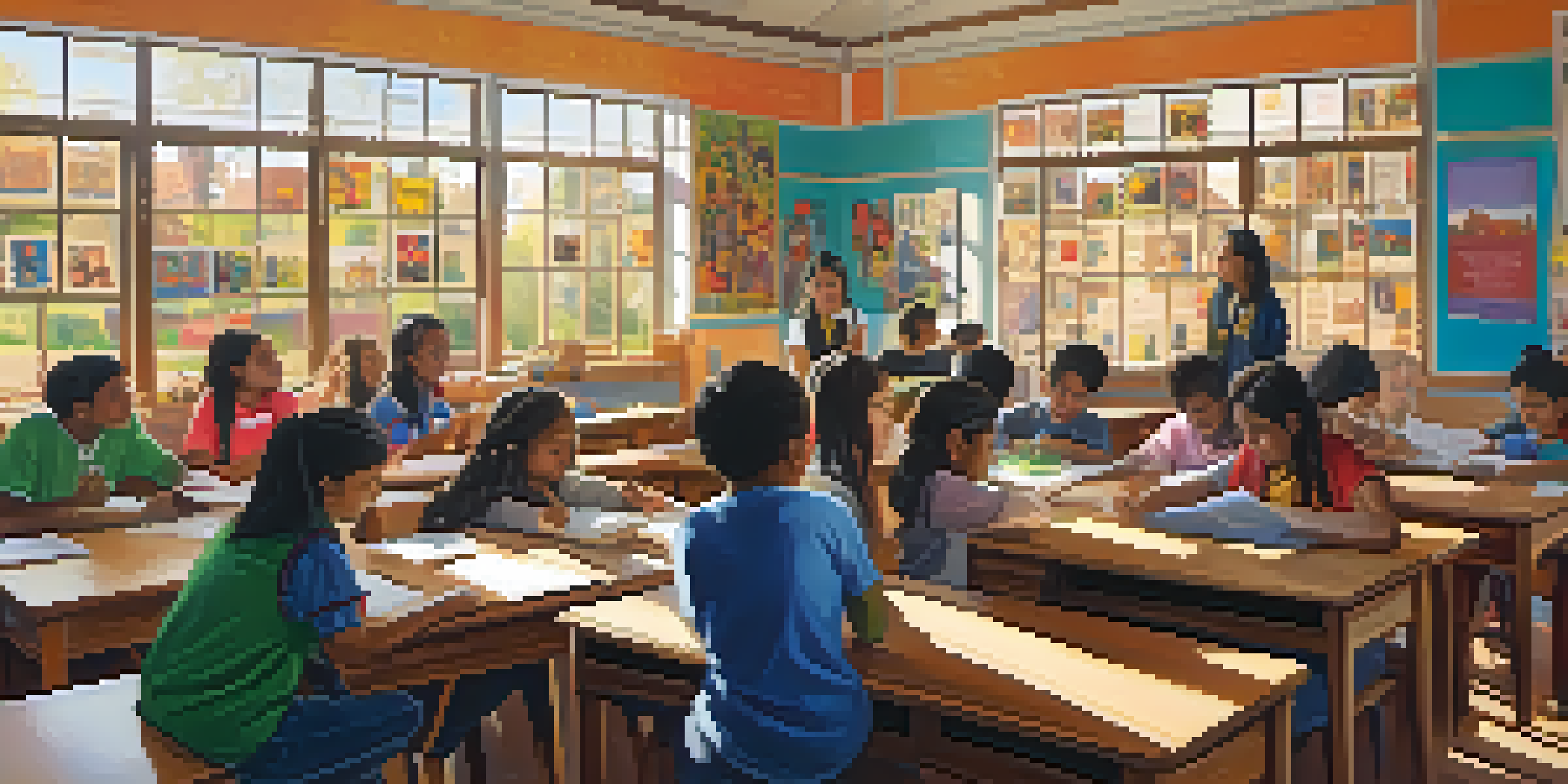The Role of Education in Promoting Cultural Heritage Awareness

Understanding Cultural Heritage: What It Entails
Cultural heritage encompasses the traditions, values, and artifacts that define a community's identity. It includes everything from art and literature to rituals and languages, providing a rich tapestry of human experience. By understanding what cultural heritage is, we can appreciate its significance in our lives and the lives of others.
Cultural heritage is the collection of our past that shapes our future.
Education serves as a bridge to this understanding, introducing students to diverse cultures and their historical contexts. Through lessons on art, history, and social studies, learners gain insights into the rich legacies that shape societies. This foundational knowledge fosters a sense of belonging and appreciation for one’s own heritage as well as others.
Moreover, cultural heritage education can spark curiosity, encouraging students to explore their own backgrounds and those of their peers. This exploration not only enhances cultural awareness but also builds empathy and respect, essential qualities in today’s interconnected world.
The Role of Schools in Cultural Heritage Education
Schools are at the forefront of promoting cultural heritage awareness. By integrating cultural studies into the curriculum, educators can help students relate lessons to real-world contexts. For instance, a history class discussing ancient civilizations can inspire students to explore their own family histories and traditions.

Additionally, schools can host cultural events, such as heritage days or international festivals, where students can showcase their backgrounds. These events create a vibrant atmosphere for sharing stories, foods, and customs, making learning interactive and engaging. When students see their culture celebrated, it instills pride and fosters a sense of community.
Cultural Heritage Shapes Identity
Understanding cultural heritage fosters appreciation for diverse traditions and values that define communities.
Furthermore, partnerships with local cultural organizations can enhance educational efforts. By inviting guest speakers or organizing field trips to museums and cultural sites, schools can provide students with firsthand experiences that deepen their understanding of cultural heritage.
Community Involvement in Promoting Heritage Awareness
While schools play a pivotal role, communities also contribute significantly to cultural heritage education. Local organizations, nonprofits, and cultural centers often provide resources and programs that complement classroom learning. Community-led initiatives can engage families, making education a collaborative effort.
The roots of education are bitter, but the fruit is sweet.
For example, workshops that teach traditional crafts or cooking can allow families to participate in their cultural practices together. Such activities not only pass down knowledge but also strengthen family bonds and community ties. By involving parents and elders in the educational process, students gain valuable insights and stories from those who lived through different cultural experiences.
Moreover, community involvement encourages a sense of ownership over cultural heritage. When individuals feel connected to their community's history, they are more likely to advocate for its preservation and promotion. This active engagement fosters cultural pride and ensures that heritage is not just learned but lived.
The Impact of Technology on Cultural Heritage Education
In today's digital age, technology plays a vital role in enhancing cultural heritage awareness. Online platforms and resources provide students access to a wealth of information about various cultures from around the globe. Virtual tours of museums, interactive timelines, and digital storytelling can make learning more engaging and accessible.
Moreover, social media allows students to connect with peers worldwide, exchanging ideas and cultural experiences. This global interaction can broaden perspectives and foster a greater appreciation for diversity. For instance, students can participate in online cultural exchange programs that facilitate direct conversations with students from different backgrounds.
Schools Promote Cultural Awareness
Educational institutions play a crucial role in integrating cultural studies, events, and community partnerships to enhance students' understanding.
However, it’s essential to approach technology thoughtfully. Educators must guide students in critically evaluating online content to differentiate between accurate information and misinformation. By teaching digital literacy alongside cultural education, we can empower students to navigate the complexities of cultural narratives in the digital landscape.
Promoting Inclusivity in Cultural Heritage Education
Inclusivity is key in cultural heritage education, ensuring that all voices are heard and represented. This means recognizing and valuing the diverse backgrounds of students in the classroom. By including materials and discussions that reflect various cultures, educators can create a more equitable learning environment.
For example, literature classes can include works from authors of different ethnicities, helping students see themselves in the stories they read. This representation fosters a sense of belonging and encourages students to share their own cultural narratives. When students feel seen and valued, they are more likely to engage deeply with the subject matter.
Furthermore, inclusivity extends to teaching methods as well. Using differentiated instruction, educators can cater to varied learning styles, ensuring that all students can connect with their cultural heritage. By embracing a range of perspectives, we enrich the educational experience for everyone involved.
Challenges in Cultural Heritage Education
Despite the benefits, promoting cultural heritage education comes with its challenges. One major hurdle is the lack of resources and training for educators. Many teachers may not feel equipped to teach about cultures outside their own, leading to a narrow perspective that can inadvertently exclude important narratives.
Additionally, there may be resistance from families or communities who feel their cultural practices are being misrepresented or oversimplified. It's crucial for educators to approach cultural heritage education with sensitivity and respect, actively seeking input from the communities they aim to represent. Building trust and open communication can help bridge these gaps.
Technology Enhances Learning Access
Digital tools and platforms provide engaging ways for students to explore global cultures and promote greater connectivity.
Finally, the fast pace of modern society often prioritizes standardized testing over comprehensive cultural education. Schools may struggle to find time within the curriculum to adequately address cultural heritage, leading to missed opportunities for enriching student learning experiences. Finding a balance between necessary academic requirements and meaningful cultural education is essential.
Future Directions for Cultural Heritage Education
Looking ahead, there are exciting opportunities to enhance cultural heritage education. As globalization continues to shape our societies, educators can leverage this trend to create more relevant and dynamic curricula. By incorporating current events and global issues, teachers can help students understand the importance of cultural heritage in a modern context.
Collaboration between schools, communities, and cultural organizations will also be vital. By pooling resources and expertise, stakeholders can create comprehensive programs that address the diverse needs of students. These partnerships can lead to innovative approaches, such as project-based learning that encourages students to explore their own cultural heritage through research and creative expression.

Finally, ongoing professional development for educators will be essential. Providing teachers with training in cultural competency and inclusive teaching practices can empower them to deliver more effective and engaging lessons. By investing in educators, we ensure that cultural heritage education remains a priority for future generations.